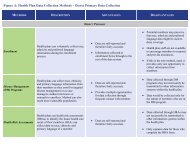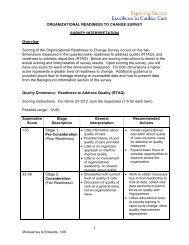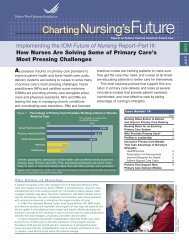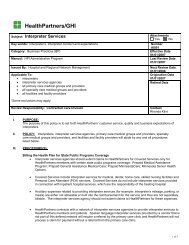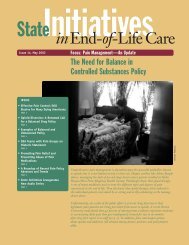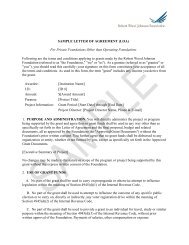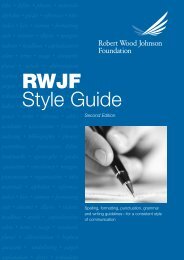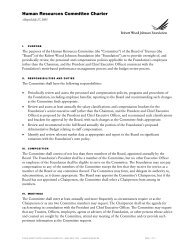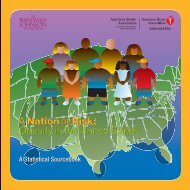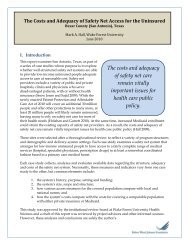Call for Proposals Brochure (PDF) - Robert Wood Johnson Foundation
Call for Proposals Brochure (PDF) - Robert Wood Johnson Foundation
Call for Proposals Brochure (PDF) - Robert Wood Johnson Foundation
Create successful ePaper yourself
Turn your PDF publications into a flip-book with our unique Google optimized e-Paper software.
40 YEARS OF IMPROVING HEALTH AND HEALTH CAREForward Promise Innovation GrantsPromoting Opportunities <strong>for</strong> the Healthand Success of Young Men of Color2012 <strong>Call</strong> <strong>for</strong> <strong>Proposals</strong>Brief Proposal DeadlineOctober 10, 2012
Program Overview(For complete details, refer to specific pages/sections noted below.)Purpose (see Background)Forward Promise Innovation Grants: Promoting Opportunities <strong>for</strong> the Health andSuccess of Young Men of Color is a new initiative of the <strong>Robert</strong> <strong>Wood</strong> <strong>Johnson</strong><strong>Foundation</strong> that aims to improve the health of middle school- and high school-agedboys and young men of color, as well as their opportunities <strong>for</strong> success in school,work, and life.Total Awards■■Up to 10 grants will be awarded under this call <strong>for</strong> proposals.■■Grantees will receive awards of up to $500,000 each <strong>for</strong> up to 30 months.Eligibility Criteria■■Preference will be given to applicant organizations that are either public entities ornonprofit organizations that are tax-exempt under Section 501(c)(3) of the InternalRevenue Code and are not private foundations or Type III supporting organizations.The <strong>Foundation</strong> may require additional documentation.■■Applicant organizations must be based in the United States or its territories.■■Organizations must have an organizational budget of at least $1.5 million annually.Selection CriteriaComplete selection criteria can be found on page 9.Key Dates and Deadlines (see Timetable)■■September 11, 2012 (1 p.m.–2 p.m. ET)—Optional applicant Web conference call.Registration is required. Please visit the program’s website <strong>for</strong> complete details andto register.■■October 10, 2012 (3 p.m. ET)—Deadline <strong>for</strong> receipt of brief proposals.■■December 17, 2012 (3 p.m. ET)—Deadline <strong>for</strong> receipt of invited full proposals.How to Apply (Page 12)<strong>Proposals</strong> <strong>for</strong> this solicitation must be submitted via the RWJF online system.Visit www.rwjf.org/cfp/fwp and use the Apply Online link. If you have not alreadydone so, you will be required to register at http://my.rwjf.org be<strong>for</strong>e you begin theapplication process.Please direct inquiries to:Maisha Simmons, MPA, program officerEmail: <strong>for</strong>wardpromise@rwjf.orgwww.rwjf.org/goto/<strong>for</strong>wardpromise2
BackgroundYoung people require support from their families,schools, communities and society as they move towardhealthy and productive adulthood. This is especiallytrue <strong>for</strong> middle school- and high school-aged boys andyoung men, many of whom encounter barriers thatmake the path to adulthood especially challenging.Boys and young men of color are more likely togrow up in poverty, live in unsafe neighborhoods,and attend schools that lack the basic resources andsupports that kids need in order to thrive. In addition,actions that might be treated as youthful indiscretionsby other young men often are judged more severelyand result in harsher punishments that have lastingconsequences. Down the road, pathways to stable,productive employment can be limited.The <strong>Robert</strong> <strong>Wood</strong> <strong>Johnson</strong> <strong>Foundation</strong>’s (RWJF)Vulnerable Populations Portfolio focuses onwhat makes people healthy—or unhealthy—froma perspective that includes factors outside of themedical care system. We recognize that to havemeaningful effect on populations that we hope tohelp, we must consider how complex social factors—poverty, education, employment, housing—affectpeople’s health, and develop solutions within thatcontext. And, we look <strong>for</strong> ideas that are ready to grow,that can thrive in new communities, and/or thatcould be expanded to help a new group of people.Through this solicitation, RWJF seeks innovativeprojects that work to improve health, education andemployment outcomes <strong>for</strong> middle school- and highschool-aged boys and young men of color. Successfulprojects will recognize that these domains do not existin isolation and that proposed interventions will requirepartnerships and holistic approaches to have sustainableimpact and improved outcomes <strong>for</strong> young men. RWJFwill support promising, innovative approaches thatare poised <strong>for</strong> growth and/or replication and havethe potential to improve the circumstances that affectyoung men of color in one of the following areas:3
■■School discipline approaches that do not pushstudents out of school. Graduating from high schoolis an important step toward success. Yet, many boysand young men of color face challenges when itcomes to staying in school. One such barrier stemsfrom harsh school discipline approaches that canoften ultimately, push young men out of school. Suchapproaches, including “zero-tolerance” policies, beganas an attempt to protect students from drugs, weaponsand violence in schools. However, these policiessometimes cause powerful unintended consequences.Over time, schools and districts have utilized outof-schoolsuspensions and expulsions <strong>for</strong> less severeschool infractions and relied more heavily on policepresence to maintain order on school campuses. Thispolicy shift disproportionately affects young menof color, whose suspension and expulsion rates farexceed those of their White peers. Moreover, existinganalyses of suspension and expulsion data at the locallevel suggest that harsh school discipline policies arenot enhancing school safety. There are commonsensealternatives to these policies that promoteaccountability <strong>for</strong> disciplinary offenses but do notpush students out of school.www.publicinterestprojects.org/wp-content/uploads/Turning-the-Tide-on-School-Discipline_v24.pdf■ ■ Early interventions that focus on dropoutprevention and increasing middle school retentionand high school graduation rates. Evidence suggeststhat better education outcomes lead to better healthoutcomes. However, only about half of AfricanAmerican, Hispanic and Native American boysgraduate from high school on time with their peers.Interventions based in both school and communitysettings are utilizing data and specific supports thatwill keep young men engaged in school. The ability todevelop early indicators that identify when a studentis likely to drop out can increase opportunitiesto retain students and keep them on track towardcompleting school. www.dropoutprevention.org/modelprograms4
■■Mental health-based interventions that tailorapproaches to boys and young men who haveexperienced and/or been exposed to violenceand trauma. Specifically, we seek innovationsthat trans<strong>for</strong>m the philosophy and culture of howorganizations provide services to youth by adoptingthe principles and practices of trauma-in<strong>for</strong>med care.Youth who grow up in neighborhoods and conditionsthat are plagued with chronic violence are morelikely to experience trauma and require services andinterventions designed to address the consequences oftrauma in individuals and facilitate healing.www.samhsa.gov/nctic/■ ■ Career training initiatives that promote bothwork<strong>for</strong>ce and education emphases to ensure thatstudents are college- and career-ready. Throughearly work experiences, part-time and summer jobs,internships, and other vocational offerings, youth canbecome familiar with workplace expectations, gaincritical skills, and develop a work portfolio. Earlywork experience also positively correlates with futurelabor market success and earnings. We are especiallyinterested in interventions designed <strong>for</strong> young menwho are recent dropouts and/or have been involvedwith the criminal justice system. www.serve.gov/newimages/council/pdf/12_0604whccs_finalreport.pdf5
The ProgramForward Promise Innovation Grants will support upto 10 programs that have the potential to achievefundamental breakthroughs in the health, educationand employment outcomes <strong>for</strong> middle school- andhigh school-aged boys and young men of color. Grantawards will be up to $500,000 each, payable over a30-month period, commencing in June 2013 andconcluding no later than December 2015. The goalis to: identify and support innovative programs thataddress the challenges facing middle school- and highschool‐aged young men of color and correspond withthe interest areas of RWJF (pgs. 4, 5); have potentialto change the organization and system(s) of servicedelivery; be poised <strong>for</strong> growth and/or replication; anddemonstrate the potential to trans<strong>for</strong>m social normswithin the context of schools and/or communities.Applicants must have implemented an existingprogram model that has a fully articulated theory ofchange or logic model, have preliminary evidenceof improving outcomes <strong>for</strong> this population, anddemonstrate potential to be replicated <strong>for</strong> broaderapplication and greater impact. Preference will be givento organizations or institutions that apply funds tosupport program infrastructure and project expansion.No more than 50 percent of the request should beallocated to existing program activities.Applicants must clearly describe a program modelthat will address at least one of the following areasof interest:■■school discipline approaches that do not push studentsout of school;■ ■ early interventions that focus on dropout preventionand increasing middle school retention and highschool graduation rates;6
■■mental health-based interventions that tailorapproaches to boys and young men who haveexperienced and/or been exposed to violence andtrauma; or■■career training programs that blend work<strong>for</strong>ce andeducation emphases to ensure that students arecollege- and career-ready.Successful projects must:■■be innovative and seek to improve the system(s) thatalready exist by making them better through newbusiness or program models;■■be based on an existing program or model ofintervention that has a fully articulated theory ofchange or logic model, show some evidence tosuggest that the program model is effective, anddemonstrate potential that the program model ispoised <strong>for</strong> growth and/or replication <strong>for</strong> broaderapplication and greater impact;■■include an innovative program of service thattargets middle school- and high school-aged youngmen of color;■■identify the target population and number ofyoung men to be served and describe the risksand expected outcomes;■■demonstrate that the proposed program or modelrepresents a departure from the status quo and hasthe potential <strong>for</strong> broader application in a differentsetting; and■ ■ demonstrate that the intervention(s) reflect a networkof support and partners that can help to generatesustainable impact and success.7
Eligibility CriteriaRWJF seeks applications from organizations and/orinstitutions with existing programs and evidence thattheir projects are improving outcomes <strong>for</strong> middleschool- and high school-aged boys and young menof color. Applicants must demonstrate potentialthat their program can be replicated <strong>for</strong> broaderapplication and greater impact. We seek to supportmodels that are diverse—both in their geographiclocation, as well as in the racial and ethnic identitiesof the young men that they serve. Projects will not beconsidered if they do not indicate explicit programemphasis on improving outcomes <strong>for</strong> middle schoolandhigh school-aged young men of color.■■Preference will be given to applicant organizationsthat are either public entities or nonprofitorganizations that are tax-exempt under Section501(c)(3) of the Internal Revenue Code and arenot private foundations or Type III supportingorganizations. The <strong>Foundation</strong> may requireadditional documentation.■■Applicant organizations must be based in the UnitedStates or its territories.■■Organizations must have an organizational budgetof at least $1.5 million annually at the time ofproposal submission.Consistent with RWJF values, this program embracesdiversity and inclusion across multiple dimensions,such as race, ethnicity, gender, age and disadvantagedsocioeconomic status. We strongly encourageapplications that will help us expand the perspectivesand experiences we bring to our work. We believethat the more we include diverse perspectives andexperiences in our work, the better we are able tohelp all Americans live healthier lives and get thecare they need.8
Selection CriteriaThe Forward Promise Innovation Grants ReviewCommittee, composed of RWJF, the ForwardPromise Advisory Council and other expertreviewers, will review proposals. All proposals willbe screened <strong>for</strong> eligibility and then reviewed usingthe following criteria:■■Commitment to improving outcomes <strong>for</strong> middleschool- and high school-aged young men of color.■■A clearly defined focus on at least one of the RWJFareas of interest.■■Rationale on how the program area will affectindividual and community outcomes.■■Demonstrated initial evidence of improved outcomes<strong>for</strong> young men.■■Description of how the project is innovative.■■Nature of collaborations and partnerships with othercommunity providers or systems.■■Potential to serve as a model <strong>for</strong> other communitiesand organizations seeking to improve outcomes <strong>for</strong>the target population.■■A clear articulation of how RWJF funds will supportbroader application of or strengthen the existing model.■ ■ An annual organizational budget of at least$1.5 million.9
Evaluation andMonitoringAn independent research group selected and fundedby RWJF will conduct an evaluation of ForwardPromise. As a condition of accepting RWJF funds, werequire grantees to participate in the evaluation.Grantees are expected to meet RWJF requirements<strong>for</strong> the submission of narrative and financial reports,as well as periodic in<strong>for</strong>mation needed <strong>for</strong> overallproject per<strong>for</strong>mance monitoring and management.We may ask project directors to participate in periodicmeetings and give progress reports on their grants. Atthe close of each grant, the lead agency is expectedto provide a written report on the project and ensurethat its findings are suitable <strong>for</strong> wide dissemination.10
Use of Grant FundsGrant funds may be used <strong>for</strong> project staff salaries,consultant fees, data collection and analysis, meetings,supplies, project-related travel, and other direct projectexpenses, including a limited amount of equipmentessential to the project. In keeping with RWJF policy,grant funds may not be used to subsidize individuals<strong>for</strong> the costs of their health care, to support clinicaltrials of unapproved drugs or devices, to construct orrenovate facilities, <strong>for</strong> lobbying, <strong>for</strong> political activities,or as a substitute <strong>for</strong> funds currently being used tosupport similar activities.Preference will be given to applicants seekingsupport to improve their program’s existinginfrastructure <strong>for</strong> expansion or replication of theprogram model. Uses of grant funds include,but are not limited to: improving the existingdata collection system, business planning andimplementation; assessment <strong>for</strong> strategic growthand/or expansion; evaluability assessments;and branding and communications strategies.Applicants may also allocate funding <strong>for</strong> programimplementation, but those resources must be linkedto implementing the capacity-building activities ofthis project. No more than 50 percent of the requestshould be allocated to existing program activities.Grantees should include travel costs in their budgets<strong>for</strong> two people to participate in up to two annualgrantee meetings, using the <strong>Foundation</strong>’s travelestimate of $1,300 per person <strong>for</strong> a two-night/two-daytrip where air travel is required. This amount shouldbe included in the proposed application budget.11
How to Apply<strong>Proposals</strong> <strong>for</strong> this solicitation must be submitted viathe RWJF online system. Visit www.rwjf.org/cfp/fwp anduse the Apply Online link. If you haven’t already doneso, you will be required to register at http://my.rwjf.orgbe<strong>for</strong>e you begin the application process.All applicants should log in to the system andfamiliarize themselves with online submissionrequirements well be<strong>for</strong>e the final submissiondeadline. Staff may not be able to assist all applicantsin the final 24 hours be<strong>for</strong>e the submission deadline.In fairness to all applicants, the program will notaccept late submissions.There are two stages in the competitive proposalprocess: (1) applicants submit a brief proposalthat describes the project and, if invited; (2) selectapplicants then submit a full proposal and line-itembudget <strong>for</strong> a grant <strong>for</strong> further consideration.Stage 1: Brief <strong>Proposals</strong>Applicants must submit a brief proposal narrative nomore than three pages that describes the project andincludes a one-page preliminary budget. The completesubmission should be no more than four pages inlength. The brief proposal must include the followingconcise descriptions of:■■The RWJF area of interest to be addressed, along withdata that support the rationale <strong>for</strong> engaging in the issue.■■The applicant organization’s capacity and how theorganization’s mission aligns with the proposed project.■■The target community, including the number ofyoung men served, geographic background, and theracial and ethnic diversity of the participants.■ ■ The program model and how it is innovative andpoised <strong>for</strong> growth and/or replication.12
■■The evidence and/or indicators of success thatdemonstrate improvement in outcomes <strong>for</strong> middleschool- and high school-aged young men of color.■■Additional partners or collaborators in the programdesign.■■Capacity-building supports requested.■■Estimated total budget request and proposed use ofRWJF funds.■■Expected duration of the proposed grant (not toexceed 30 months).Stage 2: Full <strong>Proposals</strong>Selected Stage 1 applicants will be invited byemail by November 12, 2012 to submit a fullproposal of no more than 10 pages, accompaniedby a comprehensive budget and budget narrative.Applicants who submit full proposals may beselected to participate in virtual site visits with theproposal review team. Further description of theproposal requirements will be provided to successfulStage 1 applicants.For more in<strong>for</strong>mation on the program and proposalrequirements, please contact:Maisha Simmons, MPA, program officerForward Promise: Promoting Opportunities <strong>for</strong> theHealth and Success of Young Men of ColorEmail: <strong>for</strong>wardpromise@rwjf.orgRWJF does not provide individual critiques ofproposals submitted.13
Program DirectionResponsible staff members at the <strong>Robert</strong> <strong>Wood</strong><strong>Johnson</strong> <strong>Foundation</strong> are:Jane Lowe, PhD, team directorMaisha Simmons, MPA, program officerJoann Baquilod, grants administrator14
Timetable ■ August 20, 2012RWJF online system is available to applicants.*■■September 11, 2012 (1 p.m.–2 p.m. ET)Optional applicant Web conference call. Registration isrequired. Please visit the program’s website at www.rwjf.org/goto/<strong>for</strong>wardpromise <strong>for</strong> complete details and to register.■■October 10, 2012 (3 p.m. ET)Deadline <strong>for</strong> receipt of brief proposals.*■■November 12, 2012Applicants notified if they have been invited to submit a fullproposal.■■December 17, 2012 (3 p.m. ET)Deadline <strong>for</strong> receipt of invited full proposals.*■■February 1, 2013–February 28, 2013Virtual site visits.■■March 2013Notification of awards.■■June 2013Start of grants.* All proposals must be submitted via the RWJF online system.All applicants should log in to the system and familiarizethemselves with online submission requirements well be<strong>for</strong>ethe final submission deadline. Staff may not be able to assistall applicants in the final 24 hours be<strong>for</strong>e the submissiondeadline. In fairness to all applicants, late submissions willnot be accepted.15
About the <strong>Robert</strong> <strong>Wood</strong> <strong>Johnson</strong> <strong>Foundation</strong>The <strong>Robert</strong> <strong>Wood</strong> <strong>Johnson</strong> <strong>Foundation</strong> focuses on the pressing health and health careissues facing our country. As the nation’s largest philanthropy devoted exclusively tohealth and health care, the <strong>Foundation</strong> works with a diverse group of organizationsand individuals to identify solutions and achieve comprehensive, measurable, andtimely change.For 40 years, the <strong>Foundation</strong> has brought experience, commitment, and a rigorous,balanced approach to the problems that affect the health and health care of those itserves. When it comes to helping Americans lead healthier lives and get the care theyneed, the <strong>Foundation</strong> expects to make a difference in your lifetime.For more in<strong>for</strong>mation, visit www.rwjf.org.Follow the <strong>Foundation</strong> on Twitter, www.rwjf.org/twitter or Facebook, www.rwjf.org/facebook.Sign up to receive email alerts on upcoming calls <strong>for</strong> proposals at http://my.rwjf.org.Route 1 and College Road EastP.O. Box 2316Princeton, NJ 08543-2316 August 2012




